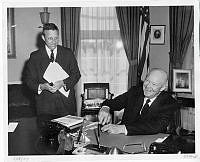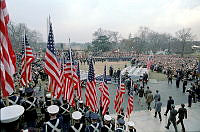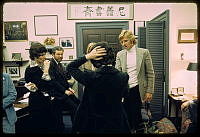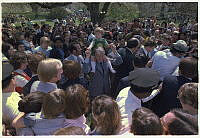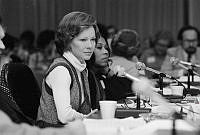Remembering My Mother in the White House
On the Occasion of the White House Historical Association's Fiftieth Anniversary
Copyright © Summer 2012 White House Historical Association. All rights reserved under international copyright conventions. No part of this article may be reproduced or utilized in any form or by any means, electronic or mechanical, including photocopying, recording, or by any information storage and retrieval system, without permission in writing from the publisher. Requests for reprint permissions should be addressed to books@whha.org
Through the vision of First Lady Jacqueline Kennedy, the White House Historical Association was chartered on November 3, 1961, “to enhance understanding, appreciation, and enjoyment of the historic White House.” In 2011, the association celebrated the occasion of its fiftieth anniversary with exhibitions, publications, and special events, including a White House reception hosted by First Lady Michelle Obama on October 31, 2011. Caroline Kennedy, the daughter of President John F. Kennedy and First Lady Jacqueline Kennedy, presented the following remarks at the reception.

Caroline Kennedy Schlossberg visits with First Lady Michelle Obama in the Green Room during a White House reception celebrating the association’s fiftieth anniversary.
Official White House Photo by Lawrence JacksonGood Afternoon. It is a great honor to be here, and I want to thank First Lady Michelle Obama for recognizing my mother and the White House Historical Association on this very special day—Halloween. One of my favorite memories of living here is dressing up in my witch costume and going over to scare my father in his office.
It is especially exciting to be here with you, Mrs. Obama, as you have redefined the role of first lady for our time. Your efforts on behalf of children and military families have inspired all Americans. You have truly made this White House into one of joyful service and mindful patriotism.
Fifty years ago, my mother brought her own sensibility to this house and to her role as first lady. Like you, her children were her priority, and she, too, saw an opportunity to use her time in the White House to educate and inform. When she first moved in, she concentrated on creating a home for her family, but she also shared my father’s love of history.

Jacqueline Kennedy inscribed her official portrait and presented it to the White House Historical Association, where it remains a treasured feature of its entrance hall. The principles of history and education that Mrs. Kennedy set down have guided the association for fifty years.
White House Historical Association/White House CollectionFor both my parents, history was not a dry academic affair but a conversation with the most interesting people you could ever hope to meet—a conversation that could help us solve the problems of our own time. My mother wanted to bring that spirit to life in the White House, so that the legacy of George Washington, Thomas Jefferson, and Abraham Lincoln would be visible to the students and families who visited here, and to the foreign heads of state who were entertained here. She also shared my father’s belief that American civilization had come of age, and she was eager to show the very best of our art and culture to the world. So she transformed the White House into one of the nation’s most important museums of American art, decorative arts, and history, and she created a stage for the greatest artists of the day.
This was more complex than simply redecorating. The project involved congressional oversight and interagency debate. My mother was determined that it be self-financing, and self-sustaining, and she was proud that it elevated academic research and scholarship in the field of American art. She was also proud that her TV tour of the White House stimulated new interest and pride in our cultural heritage.
My mother set up the Fine Arts Committee for the White House, founded the White House Historical Association, and reorganized the White House Library to showcase works of American literature. She created, and mostly wrote, the association’s first guidebook—The White House: An Historic Guide—and got Arthur Schlesinger to help with a book of one-page presidential biographies that is still sold today. Of course people were eager to help her, but this was an ambitious, high-visibility undertaking, and though it’s hard to believe today, it was also controversial, and carried political risks.

It was through the work of Jacqueline Kennedy that both the White House Historical Association and its flagship publication, The White House: An Historic Guide, were created. President John F. Kennedy and First Lady Jacqueline Kennedy were presented with copies of the first edition of the Guide upon its release in 1962. It has remained in print ever since.
Incredibly, many of my father’s advisers lined up against the White House restoration, which they thought was too elitist, and they were particularly concerned about the propriety of creating a guidebook. I recently came across a few memos on the subject and I thought you might like to hear an excerpt. This is from the “Memorandum to the President re Proposed Sale of Mementos in the White House,” dated September 6, 1961. It was written by Jack McNally, a loyal Irishman from Worcester, Massachusetts, who was put in charge of White House administration. He attached supporting memos from the White House Police, Secret Service, and the Department of the Interior, all of which joined him in opposing the idea of a guidebook.
In behavior that could not be called a “Profile in Courage,” my father just handed the memo to his secretary to forward to my mother who was still on the Cape. It reads in part:
"We must take into consideration the possibility of severe criticism from the public. . . . Frequent references are made by tourists that commercialism does not and never has existed in any form in the President's home. . . . Consideration must also be given to the impressions formed by visiting dignitaries who would be exposed to such a commercial venture in the President's home. Also, possible criticism from the Press, and Members of Congress. . . . As examples of the criticism that might result, we would like to cite the unfavorable publicity that was given the Truman Balcony and the efforts of the Eisenhower Administration to keep the squirrels off the President’s putting green. This last reference was too much for my mother, who wrote in the margin: “Absurd. How stupid. This is not a concession stand. There is absolutely no connection.” Like other people who came up against my mother, McNally and his cohorts didn’t stand a chance.

In 2011 the White House Historical Association celebrated the release of the fiftieth anniversary edition of the Guide with a signing at the White House Visitor Center. The book, first conceived of and edited by First Lady Kennedy, was an ambitious and initially controversial project.
As the project got under way, my father was tremendously proud of my mother, and she in turn was thrilled to have made a positive and symbolic contribution to his presidency. Their time in the White House was the happiest of their lives.
Most of all, my mother was a patriot. She believed that living in the White House was the greatest privilege one could have, and she worked hard to be worthy of the honor. She loved my father, and her courage held this country together after his death. And when it was over, she resumed the life of a private citizen, a status she cherished.
Then, like so many women of her generation, my mother went back to work when her children were grown. She continued to advocate for historic preservation, mixed-use neighborhoods, and the quality of urban life. She was proud that she had convinced my father to save Lafayette Square, and she continued working to transform Pennsylvania Avenue into a noble artery of government that reflects the strength of American democracy. In New York, she led the fight to save Grand Central Station and secured that victory with a landmark Supreme Court decision.

In 2011 the association celebrated the release of the fiftieth anniversary edition of the Guide with a signing at the White House Visitor Center. The book, first conceived of and edited by Mrs. Kennedy, was an ambitious and initially controversial project.
In many ways, both private and public, my mother defined the role of first lady for the modern age. She straddled two eras, the one she describes in her oral history when women stayed home and had few opinions that differed from their husband’s, and the coming age when women broke free to become independent and self-supporting. She lived fully in both. Though she rarely talked about herself, and gave almost no interviews, her evolution as a public figure, and her life as a private citizen, inspired millions of women to live life on their own terms and continues to do so today.
She would be so proud of the ongoing work of the White House Historical Association, its education programs and outreach efforts, and grateful to all of you who have made this day possible.














